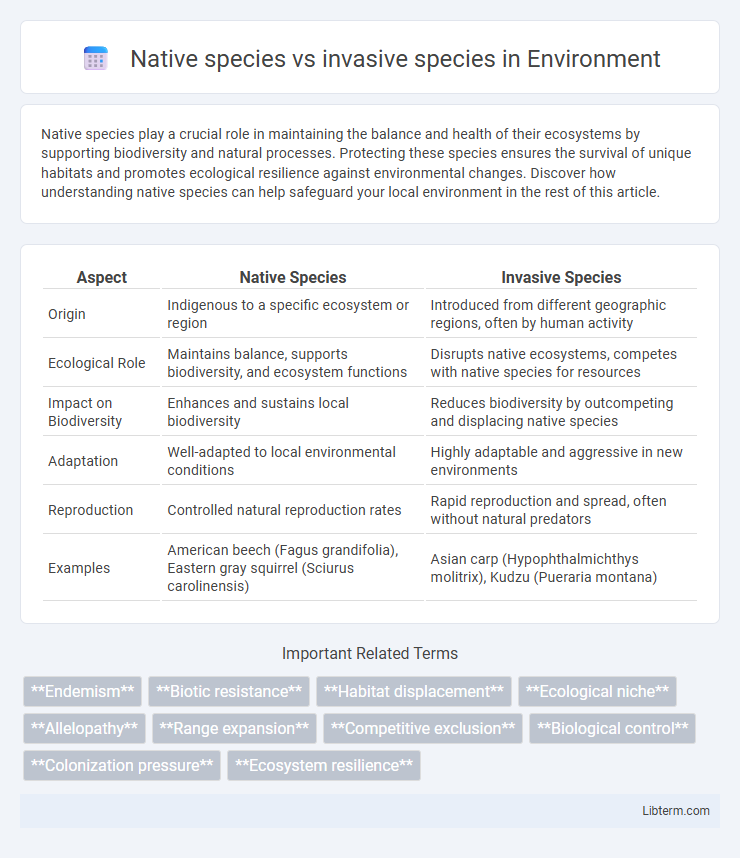Native species play a crucial role in maintaining the balance and health of their ecosystems by supporting biodiversity and natural processes. Protecting these species ensures the survival of unique habitats and promotes ecological resilience against environmental changes. Discover how understanding native species can help safeguard your local environment in the rest of this article.
Table of Comparison
| Aspect | Native Species | Invasive Species |
|---|---|---|
| Origin | Indigenous to a specific ecosystem or region | Introduced from different geographic regions, often by human activity |
| Ecological Role | Maintains balance, supports biodiversity, and ecosystem functions | Disrupts native ecosystems, competes with native species for resources |
| Impact on Biodiversity | Enhances and sustains local biodiversity | Reduces biodiversity by outcompeting and displacing native species |
| Adaptation | Well-adapted to local environmental conditions | Highly adaptable and aggressive in new environments |
| Reproduction | Controlled natural reproduction rates | Rapid reproduction and spread, often without natural predators |
| Examples | American beech (Fagus grandifolia), Eastern gray squirrel (Sciurus carolinensis) | Asian carp (Hypophthalmichthys molitrix), Kudzu (Pueraria montana) |
Introduction to Native and Invasive Species
Native species are organisms that naturally occur and have evolved in a specific region, playing a crucial role in maintaining local ecosystems and biodiversity. Invasive species, introduced either intentionally or accidentally outside their native habitats, often disrupt these ecosystems by outcompeting native species, altering habitats, and threatening ecological balance. Understanding the distinction between native and invasive species is essential for effective conservation and management strategies to protect natural environments.
Defining Native Species
Native species are organisms that naturally occur and have evolved within a specific geographic area or ecosystem over long periods, establishing a balanced relationship with other local species. These species contribute to biodiversity, ecosystem stability, and the natural functioning of habitats by occupying specific ecological niches. Defining native species involves understanding their historical presence before significant human interference or introduction of non-native species.
Defining Invasive Species
Invasive species are non-native organisms introduced to new environments where they cause ecological harm, outcompeting native species for resources. These species disrupt local ecosystems by altering habitat structures, reducing biodiversity, and impacting native species populations. Identifying invasive species involves assessing their rapid spread, adaptability, and negative effects on native flora and fauna.
Key Differences Between Native and Invasive Species
Native species evolved naturally in a specific ecosystem, maintaining balanced interactions with other organisms and contributing to biodiversity. Invasive species are non-native organisms introduced intentionally or accidentally, often disrupting ecosystem stability by outcompeting native species for resources. Key differences include origin, ecological impact, and adaptation strategies, with native species supporting ecosystem health and invasives causing habitat degradation and loss of native biodiversity.
Ecological Roles of Native Species
Native species play critical ecological roles by maintaining biodiversity, supporting food webs, and stabilizing ecosystems through nutrient cycling and habitat formation. They have co-evolved with their environment, fostering balanced interactions with other native organisms that regulate population dynamics and promote ecosystem resilience. The disruption caused by the introduction of invasive species often undermines these established roles, leading to habitat degradation and loss of native species diversity.
Impacts of Invasive Species on Ecosystems
Invasive species disrupt native ecosystems by outcompeting indigenous flora and fauna for resources, leading to reduced biodiversity and altered habitat structures. They can introduce novel diseases, prey on native species, and disrupt nutrient cycling, causing long-term ecological imbalance. Ecosystem services such as pollination, water purification, and soil fertility often decline as invasive species dominate, threatening both environmental health and human livelihoods.
Case Studies: Notable Native and Invasive Species
The gray wolf, a native species of North America, plays a crucial role in maintaining ecosystem balance by regulating prey populations and supporting biodiversity. In contrast, the invasive emerald ash borer has devastated ash tree populations across the United States, causing significant ecological and economic damage. Case studies from Yellowstone National Park highlight the recovery of native species like elk due to gray wolf reintroduction, while regions in the Midwest struggle with the emerald ash borer's widespread destruction.
Human Influence and the Spread of Invasive Species
Human activities such as global trade, transportation, and urban development significantly accelerate the spread of invasive species beyond their native habitats. These non-native species often outcompete local flora and fauna, disrupting ecosystems and threatening biodiversity. The introduction of invasive species through ballast water discharge, plant trade, and pet releases highlights the direct human role in altering natural species distributions.
Strategies for Managing Invasive Species
Effective strategies for managing invasive species emphasize early detection and rapid response to prevent establishment and spread. Biological control methods, such as introducing natural predators or pathogens, help reduce invasive populations without harming native species. Habitat restoration and public education campaigns support long-term resilience of native ecosystems against invasive threats.
Conservation Efforts to Protect Native Species
Conservation efforts to protect native species prioritize habitat restoration, invasive species control, and community education to maintain ecosystem balance. Programs often include targeted removal of invasive species such as kudzu or zebra mussels, which outcompete native flora and fauna like the Eastern Hemlock and freshwater mussels in North America. Preserving native biodiversity supports ecosystem services crucial for pollination, water purification, and soil health.
Native species Infographic

 libterm.com
libterm.com